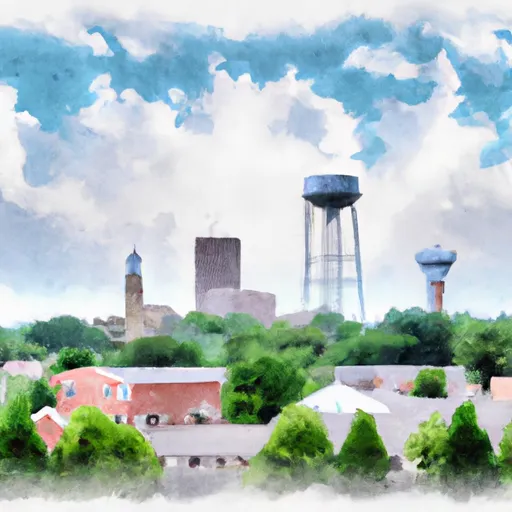-
 Snoflo Premium
Snoflo Premium
Get unlimited access to all our content
With no Ad interruptions! - Start Your Free Trial Login with existing account
La-Harpe
Eden Index
Climate
8.1
•
Recreation
3.4
•
Community
1.5
•
Safeguard
4.8/10

La Harpe, located in Illinois, experiences a humid continental climate with four distinct seasons. Summers are warm and humid, with average temperatures ranging from the mid-70s to low 80s Fahrenheit, while winters are cold, with temperatures averaging in the mid-20s to low 30s Fahrenheit. The area receives moderate rainfall throughout the year, with slightly higher precipitation in the spring and summer months.
La Harpe is surrounded by abundant water resources, including the La Harpe Creek and numerous small lakes and ponds. These hydrological features provide opportunities for various recreational activities such as fishing, boating, and kayaking. The nearby Argyle Lake State Park, encompassing approximately 1,700 acres, is a popular destination for outdoor enthusiasts. The park offers hiking trails, camping facilities, and a 93-acre lake where visitors can enjoy fishing, swimming, and non-motorized boating.
Additionally, La Harpe boasts several parks and green spaces within the town, providing residents and visitors with opportunities for picnicking, walking, and enjoying outdoor leisure activities. The local community takes pride in its natural surroundings and often organizes events and festivals that celebrate the outdoors, highlighting the town's commitment to providing a diverse range of outdoor recreation opportunities.
What is the Eden Index?
The Snoflo Eden Index serves as a comprehensive rating system for regions, evaluating their desirability through a holistic assessment of climate health, outdoor recreation opportunities, and natural disaster risk, acknowledging the profound impact of these factors on livability and well-being.
Climate Health Indicator (CHI): 8.1
La-Harpe receives approximately
1000mm of rain per year,
with humidity levels near 83%
and air temperatures averaging around
11°C.
La-Harpe has a plant hardyness factor of
5, meaning
plants and agriculture in this region thrive during a short period during spring and early summer. Most
plants will die off during the colder winter months.
By considering the ideal temperature range, reliable water supplies, clean air, and stable seasonal rain or snowpacks, the Climate Health Indicator (CHI) underscores the significance of a healthy climate as the foundation for quality living.
A healthy climate is paramount for ensuring a high quality of life and livability in a region, fostering both physical well-being and environmental harmony. This can be characterized by ideal temperatures, reliable access to water supplies, clean air, and consistent seasonal rain or snowpacks.
Weather Forecast
Streamflow Conditions
Lower Illinois
Area Rivers
Lower Illinois
Snowpack Depths
Lower Illinois
Reservoir Storage Capacity
Lower Illinois
Groundwater Levels
Recreational Opportunity Index (ROI): 3.4
The Recreational Opportunity Index (ROI) recognizes the value of outdoor recreational options, such as parks, hiking trails, camping sites, and fishing spots, while acknowledging that climate plays a pivotal role in ensuring the comfort and consistency of these experiences.
Access to outdoor recreational opportunities, encompassing activities such as parks, hiking, camping, and fishing, is crucial for overall well-being, and the climate plays a pivotal role in enabling and enhancing these experiences, ensuring that individuals can engage in nature-based activities comfortably and consistently.
Camping Areas
| Campground | Campsites | Reservations | Toilets | Showers | Elevation |
|---|---|---|---|---|---|
| Clear Spgs Rec Area | 45 | 317 ft | |||
| Grand Gulf Military Park | 42 | 238 ft | |||
| Rocky Springs - Natchez Trace Pkwy | 22 | 235 ft | |||
| Little Sunflower River | None | 107 ft | |||
| Leroy Percy State Park | None | 108 ft | |||
| North Rec Composite | 15 | 97 ft | |||
| Warfield Point Park | None | 132 ft | |||
| Great River Road State Park | None | 150 ft | |||
| Lamar Dixon Expo RV Center | 300 | 11 ft | |||
| South Recreation Composite | 100 | 140 ft |
Nearby Ski Areas
Catastrophe Safeguard Index (CSI):
The Catastrophe Safeguard Index (CSI) recognizes that natural disaster risk, encompassing floods, fires, hurricanes, and tornadoes, can drastically affect safety and the overall appeal of an area.
The level of natural disaster risk in a region significantly affects safety and the overall livability, with climate change amplifying these risks by potentially increasing the frequency and intensity of events like floods, fires, hurricanes, and tornadoes, thereby posing substantial challenges to community resilience and well-being.
Community Resilience Indicator (CRI): 1.5
The Community Resilience Indicator (CRI) recognizes that education, healthcare, and socioeconomics are crucial to the well-being of a region. The CRI acknowledges the profound impact of these elements on residents' overall quality of life. By evaluating educational resources, healthcare accessibility, and economic inclusivity, the index captures the essential aspects that contribute to a thriving community, fostering resident satisfaction, equity, and social cohesion.

